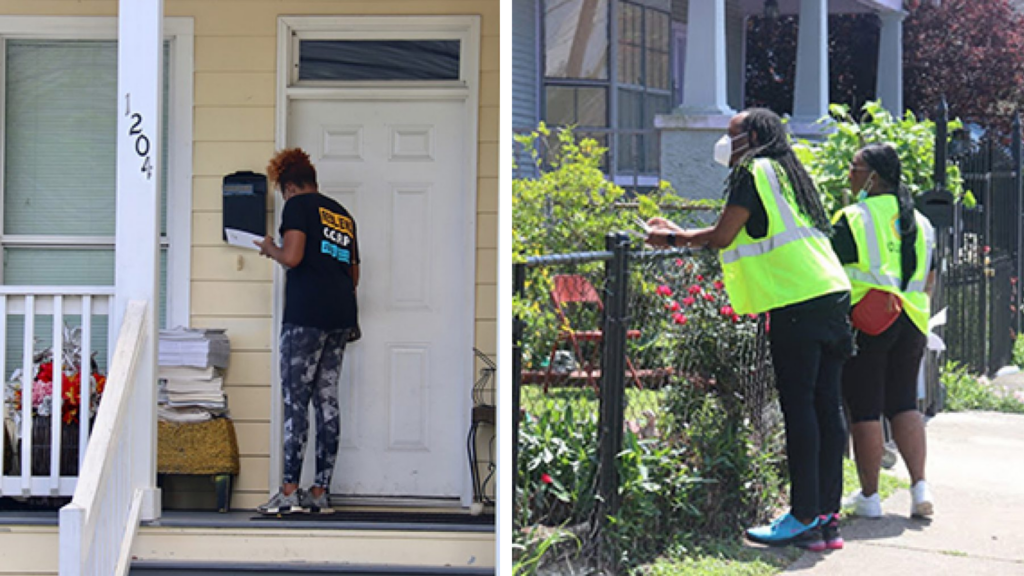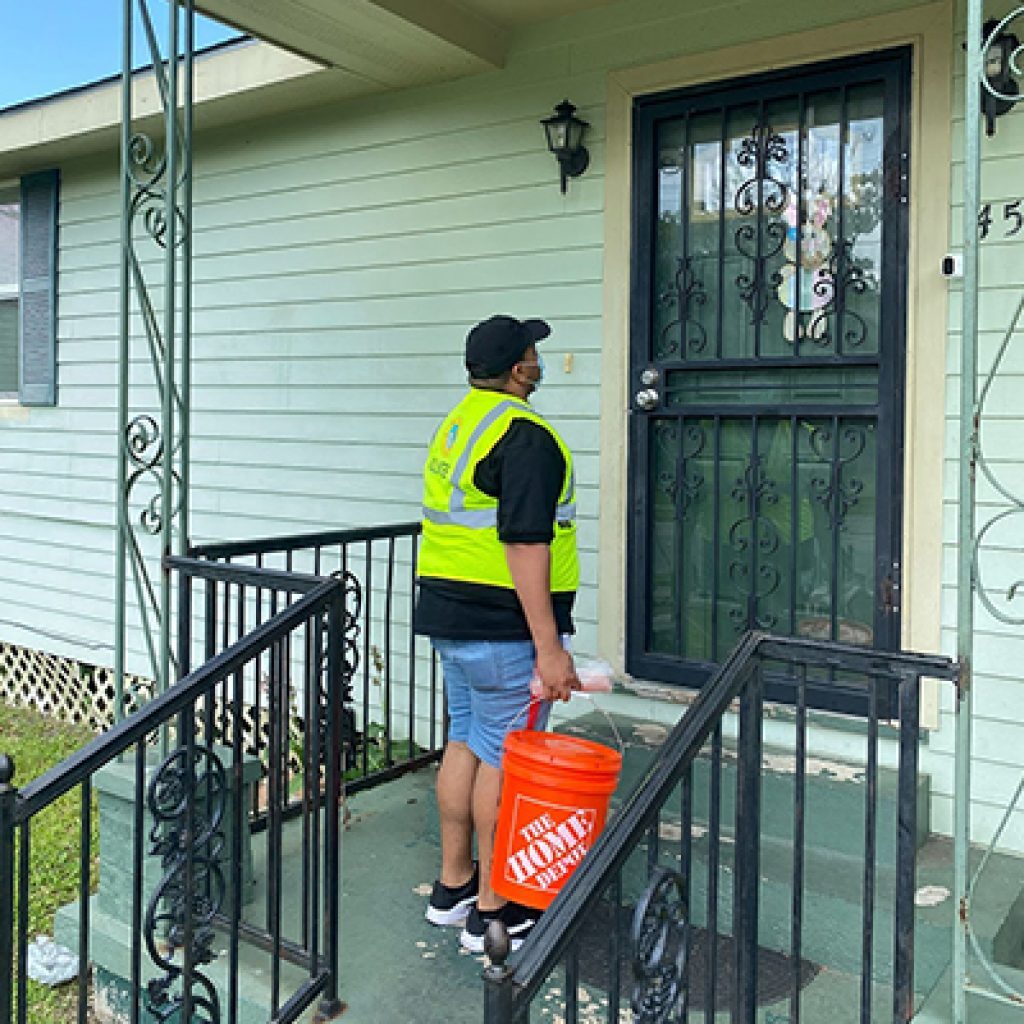With climate disasters on the rise, resilience efforts must adapt. Resilience Force is a new initiative an effort led by women of color providing disaster relief to the most vulnerable.

People, most whom are Black, stranded on rooftops, surrounded by floodwaters with debris, vehicles and bodies floating by—it’s hard for any American to forget the images of Hurricane Katrina’s aftermath, let alone for the people of New Orleans. Katrina, one of the strongest storms to hit the U.S. coast in 100 years, left behind severe destruction after it made contact on the Gulf Coast in August 2005 and provided additional proof that Black and brown people are affected most severely by natural disasters.
A new report by the disaster response organization Resilience Force (RF) shows disasters reinforce social inequalities, which are felt most acutely by people of color, women, low-income communities, immigrants and disabled people.
Resilience Force wants to transform America’s disaster response by establishing and strengthening a “Resilience Workforce”—think: first responders, daycare workers, health professionals—whose work, heart and expertise make sustainable recovery from disasters possible.
“It is the disaster response and recovery model of the future,” LaTanja Silvester, Louisiana director of RF, told Ms. She says the government and existing power structures have historically failed to ensure the safety of people of color, low income communities and immigrants in the face of disasters. RF works with local, well trained and well paid resilience workers to create an alternative model.
“Just imagine if there are these boots on the ground, readily responding, highly trained individuals who are culturally competent and from the community, available after any disaster,” said Silvester.
The Louisiana chapter of RF has been active since 2020. In the past two years, the majority of their work has been COVID-related. According to Silvester, testing rates in New Orleans increased by 60 percent after Resilience Force started doing outreach and providing testing. The key component for success: community organizing.
“In any advocacy, there has to be a component of organizing,” Silvester said.
Effective advocacy makes people understand structures like the healthcare system or the political system and how these structures impact them. In their efforts to educate the public about the COVID-19 pandemic, the 20 “community help workers” employed by Resilience Force went into communities to have conversations with people, instead of just telling them to get vaccinated.
Women in the Resilience Force
The COVID-19 pandemic revealed inequities that women in New Orleans experienced, says Silvester. “Specifically Black women … were severely affected by COVID because most of their jobs were in the hospitality, leisure and tourism industries.” To Silvester, disaster resilience, in the cases of both COVID and natural disasters, is a feminist issue.
Apart from directly supporting those most vulnerable community members, Resilience Force also acts as a workforce development program, primarily hiring people who had lost their jobs due to COVID. Having experienced what it means to be affected by disaster, these workers, many of them women, were “so willing to get on the ground and help those most vulnerable people throughout our city,” Silvester said.
It is the disaster response and recovery model of the future. Just imagine if there are these boots on the ground, readily responding, highly trained individuals who are culturally competent and from the community, available after any disaster.
LaTanja Silvester
This form of direct outreach also has the potential to address another issue related to disasters: the increase of domestic violence in disaster aftermath. RF’s community help workers seek out in-depth conversations with those affected, where they are able to discover and address issues like domestic violence much more effectively than traditional disaster recovery efforts. To ensure they are well-equipped for these scenarios, RF workers are trained extensively in how to support survivors of domestic violence.
This training is essential to making this model work, Sylvester says. Most RF employees were hired during COVID; pandemic-related resilience work is different than that of natural disasters, such as hurricanes. But from the beginning, they received training to prepare them for the work they would do when the next storm hits.
During Hurricane Ida in August of 2021, the Resilience Force workers were out connecting with communities and doing wellness checks with those who remained in the city. They delivered medication, food and water while making sure the most vulnerable people were still connected to the community.
In a debrief session with the workers afterwards, things got emotional, Sylvester says. Ida had been the first time the community help workers were needed in disaster relief work on the ground, and the response by the community was overwhelming. People were very grateful for the training they received, Sylvester said, because it allowed them to respond in depth to the needs of the people.
Resilience Force and Worker Rights
Silvester says the work at Resilience Force “focuses on the intersection of some of the pressing issues in our country right now—that is immigration worker and migrant rights, climate change and the natural disaster economy.” For example, the RF community pushes for the rights of all workers helping communities rebuild after disasters to be protected. Ensuring protection and a pathway to citizenship for immigrant workers is an essential aspect of this.
In their latest report on climate resilience, RF tells the story of 46-year-old Honduran immigrant Mariano who was working in Florida after Hurricane Michael. When it started raining while he was tarping a roof, his supervisor would not let him stop. Mariano fell and hit his head, resulting in major injuries he was still recovering from two years later. Mariano’s story is just one example of the lack of protection for immigrant workers, who make up a large percentage of the rebuilding workforce. As a response, Resilience Force has started the “Immigrants are Essential” project, demanding living wages, protection and a path to citizenship for immigrant workers.
These demands are also incorporated in the Climate Resilience Workforce Act. In this act, Rep. Pramila Jayapal (D-Wash.) highlights the disproportionate effects climate disasters have on low-income communities, communities of color and indigenous communities. She also recognizes the important role immigrant workers have in the rebuilding and recovery efforts after natural disasters. The act would “create the decentralized, skilled, equitable workforce our nation needs to achieve climate resilience”.
“Resilience Force is rewriting the rules, trying to remove some of the barriers that are holding this workforce back from helping America rebuild,” Silvester said.
To support the efforts of Resilience Force, you can donate on their website. To support the Climate Resilience Workforce Act, contact your member of Congress and urge them to support or cosponsor the bill.
Up next:






